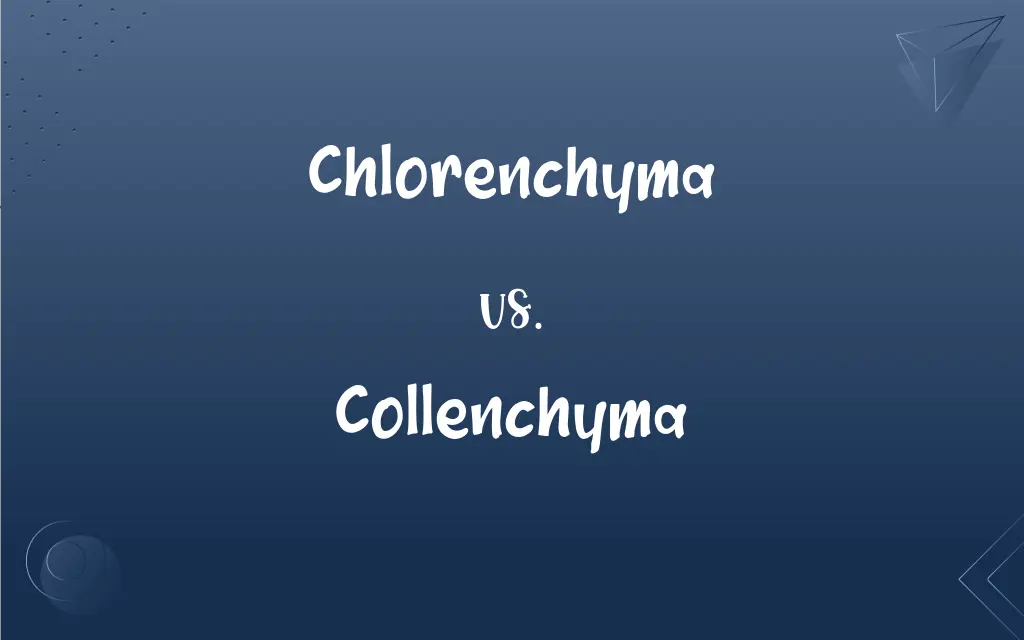Chlorenchyma vs. Collenchyma: What's the Difference?
Edited by Janet White || By Harlon Moss || Updated on October 28, 2023
Chlorenchyma contains chloroplasts for photosynthesis, while collenchyma provides mechanical support with thickened cell walls.

Key Differences
Chlorenchyma and collenchyma are specialized types of parenchyma cells found in plants. Chlorenchyma cells, as the name suggests, are rich in chloroplasts, making them essential for photosynthesis in plants. These cells are often found in leaves and other green parts of the plant where photosynthesis primarily takes place. Collenchyma cells, on the other hand, play a different role; they are known for providing mechanical support to growing parts of the plant.
While chlorenchyma focuses on the plant's energy production via photosynthesis, collenchyma is more about structure. Collenchyma cells have unevenly thickened primary cell walls, which allow them to stretch and provide flexibility. This characteristic makes collenchyma especially prominent in young stems and petioles, helping the plant maintain its shape and resist external pressures.
Chlorenchyma's primary function revolves around its chloroplast content. These chloroplasts trap sunlight and convert it into energy through photosynthesis, making chlorenchyma a vital component for the plant's growth and energy needs. Conversely, collenchyma's thickened walls, while not involved in photosynthesis, give strength to plant structures without compromising flexibility.
One interesting aspect of chlorenchyma is its adaptability. In conditions where light is limited, chlorenchyma cells can differentiate back into regular parenchyma cells. Collenchyma, by contrast, remains consistent in its function of providing mechanical strength. The adaptability of chlorenchyma versus the consistent support role of collenchyma showcases the diverse ways plants have evolved to survive in varying conditions.
Comparison Chart
Primary Function
Photosynthesis
Mechanical support
ADVERTISEMENT
Cell Wall Thickness
Evenly thin
Unevenly thickened
Location in Plants
Primarily in leaves
Young stems and petioles
Adaptability
Can differentiate back to regular parenchyma in low light
Remains consistent in function
Associated Structures
Chloroplasts
Thickened primary cell walls
Chlorenchyma and Collenchyma Definitions
Chlorenchyma
Chlorenchyma is a specialized parenchyma cell rich in chloroplasts.
The green color in leaves is due to the chlorenchyma's chloroplast content.
ADVERTISEMENT
Collenchyma
Collenchyma is a type of plant tissue providing mechanical support.
The flexibility in young stems is due to the presence of collenchyma.
Chlorenchyma
Chlorenchyma plays a pivotal role in photosynthesis.
Without chlorenchyma, plants would struggle to produce energy from sunlight.
Collenchyma
Collenchyma cells have unevenly thickened primary cell walls.
The irregular thickening in collenchyma walls provides both strength and flexibility.
Chlorenchyma
Chlorenchyma cells can adapt based on light availability.
In darker environments, chlorenchyma can revert to regular parenchyma.
Collenchyma
Collenchyma does not participate in photosynthesis.
While green, collenchyma's primary role isn't photosynthesis like chlorenchyma.
Chlorenchyma
Chlorenchyma is primarily found in the green parts of plants.
The abundant chlorenchyma in leaves allows for efficient photosynthesis.
Collenchyma
Collenchyma offers structural support without restricting growth.
As plants grow, collenchyma provides the needed support without hindrance.
Chlorenchyma
Chlorenchyma's thin cell walls are packed with chloroplasts.
The high chloroplast density in chlorenchyma enables optimal light absorption.
Collenchyma
Collenchyma is commonly found in young plant parts.
The soft parts of young plants are often reinforced with collenchyma tissue.
Chlorenchyma
Plant tissue consisting of parenchyma cells that contain chloroplasts.
Collenchyma
A supportive tissue of plants, consisting of elongated living cells with unevenly thickened walls.
Chlorenchyma
(botany) A mechanical, supportive ground tissue in plants containing chloroplasts.
Collenchyma
(biology) A living, elongated, mechanical and flexible ground tissue with angular pectin depositions; present just under leaves, tendrils and stems of climbers; formed before vascular differentiation.
Chlorenchyma
Parenchyma whose cells contain chloroplasts
Collenchyma
A tissue of vegetable cells which are thickend at the angles and (usually) elongated.
FAQs
What is the primary function of chlorenchyma?
Chlorenchyma's primary function is photosynthesis due to its rich chloroplast content.
Are chlorenchyma cells always involved in photosynthesis?
Primarily yes, but in low light, chlorenchyma can differentiate back to regular parenchyma.
Can collenchyma cells carry out photosynthesis?
No, collenchyma cells are primarily for mechanical support and don't participate in photosynthesis.
Are chlorenchyma and collenchyma found together in plant structures?
They can be, especially in green stems where photosynthesis and mechanical support are both needed.
What's the significance of the uneven cell walls in collenchyma?
The unevenly thickened cell walls in collenchyma allow for both strength and adaptability in growing plant parts.
Where can one typically find collenchyma in plants?
Collenchyma is commonly found in young stems and petioles.
Why are collenchyma cells essential for young plants?
Collenchyma cells provide strength and flexibility to growing parts of the plant, aiding in structural support.
Do chlorenchyma cells contain a high amount of chloroplasts?
Yes, chlorenchyma cells are densely packed with chloroplasts to maximize photosynthesis.
Which cell type, chlorenchyma or collenchyma, contains chloroplasts?
Chlorenchyma contains chloroplasts, while collenchyma does not.
Do chlorenchyma cells play a structural role in plants?
While chlorenchyma mainly focuses on photosynthesis, they do contribute to plant structure but not as significantly as collenchyma.
Which tissue, chlorenchyma or collenchyma, is more abundant in leaves?
Chlorenchyma is more abundant in leaves due to its role in photosynthesis.
How does collenchyma support plants?
Collenchyma provides mechanical support with its unevenly thickened cell walls, offering flexibility and strength.
What gives chlorenchyma cells their green color?
The green color of chlorenchyma cells comes from the chloroplasts they contain.
How do the cell walls of chlorenchyma and collenchyma differ?
Chlorenchyma has evenly thin walls, while collenchyma has unevenly thickened primary cell walls.
How does collenchyma differ from other supporting tissues in plants?
Collenchyma offers support without being woody or hard, allowing for flexibility in growing parts.
Are both chlorenchyma and collenchyma forms of parenchyma?
Yes, both are specialized forms of parenchyma cells with distinct functions in plants.
Can chlorenchyma cells adapt to different environments?
Yes, chlorenchyma cells can differentiate back to regular parenchyma in conditions of low light.
Is collenchyma present in mature plant parts?
Generally, collenchyma is more prominent in young plant parts, though it can be present in mature areas requiring flexibility.
Are collenchyma cells flexible?
Yes, collenchyma cells provide flexibility due to their unevenly thickened cell walls.
Can chlorenchyma cells revert to other cell types?
In low light conditions, chlorenchyma can differentiate back to regular parenchyma.
About Author
Written by
Harlon MossHarlon is a seasoned quality moderator and accomplished content writer for Difference Wiki. An alumnus of the prestigious University of California, he earned his degree in Computer Science. Leveraging his academic background, Harlon brings a meticulous and informed perspective to his work, ensuring content accuracy and excellence.
Edited by
Janet WhiteJanet White has been an esteemed writer and blogger for Difference Wiki. Holding a Master's degree in Science and Medical Journalism from the prestigious Boston University, she has consistently demonstrated her expertise and passion for her field. When she's not immersed in her work, Janet relishes her time exercising, delving into a good book, and cherishing moments with friends and family.































































